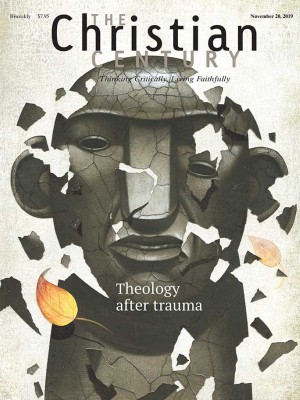December 8, Advent 2A (Matthew 3:1–12)
In the stitched-together story of Advent, we wrestle with each other’s certainties.
To call my maternal grandparents thrifty would be a gross understatement. Grandma washed and reused the bags in which sliced bread was sold. Grandpa was unashamed to pick through folks’ trash in an effort to find something that could be repurposed. Until they died a few years ago, their small farmhouse in central Indiana had the same worn and lumpy green carpet, accented by orange-striped wallpaper, from my mother’s childhood.
So you might imagine how surprised we all were in the late 1980s when a construction crew showed up to replace their back stoop with a grand concrete patio.
It was quite the undertaking. They dug up trees and shrubs, scraped away mounds of dirt, and raked in a dump truck full of gravel. They used forms to make a variety of textured slabs at ground level and even bigger forms to create two levels of beds for ornamental flowers.
Read our latest issue or browse back issues.
All that work caused quite a disturbance for the local creatures that lived in the long-untouched soil surrounding the house. Bees, whose hive likely collapsed in the early digging, crawled out with furious buzzing. A horde of mice found their way into the house and set off traps. And when the concrete was being poured, all manner of crawling, squirming things got stuck in it as it cured.
This was bewildering to us children. We’d complain about the influx of diminutive beasts with their stinging and scurrying. And Grandma would say, “When you cause a ruckus, you’re always gonna stir things up.”
That was all well and good until the day the snakes came. Grandma, adorned in her pink housecoat and Grandpa’s muddy boots, was taking the laundry out to dry when a pair of young gray rat snakes shimmied their way across those new patio slabs. She screamed and dropped the laundry basket from her hip with a thud. After quickly surveying the landscape, she found a hoe and used it to sever each of them near their middles.
Hearing the commotion, Grandpa came running over from the garden, and they met up the driveway to have words. She thought they were beyond my range of hearing, but I could hear her well enough.
She said, “This is why we leave things as they are.”
When John first appears in Matthew’s Gospel, baptizing at the river’s edge, he seems okay with what he’s stirred up. Word has spread up and down the river, and a great many are coming to him from all over the place. They’re listening, and he’s getting what he believes God wants.
But when the Pharisees and Sadducees arrive, all that changes. John receives what he’s expecting and still manages to get upset by the results.
These select visitors, representatives of established religion, come to the river and are called names. They have their motives questioned and their faith challenged. This is within John’s wheelhouse, as indicated by his uniform. Shaking the powerful into repentance is a prophet’s job.
Still, it’s an interesting narrative choice to create this conflict before providing any context as to who these leaders are. It is likely evidence that, unlike the Gospel of John with all its parentheses, Matthew assumes its readers already know the players. Later readers, however, would be left to decide in the moment: Do I trust the guy from the backwoods, or do I trust these proper-noun-bearing visitors? The latter might be the easier choice.
We get no indication that John is as emphatic to the average Judeans as he is to those who draw his ire. We’re left to wonder if he holds them to the same standard as the ones he calls snakes. Was their brand of religiosity more palatable? Did they get a pass that the leaders didn’t because they weren’t as vocal or disruptive?
Ironically, Matthew’s baptizer—a prototype for Jesus—seems to have the same kind of religious rigidity that his rivals later apply to Jesus. John is appalled that they would come to the water without the right kind of repentance. The Pharisees and Sadducees are appalled by work Jesus does on the sabbath.
Jesus isn’t here yet, however. In the stitched-together story of Advent, Jesus isn’t in the scene. He’s off in the wings. And while waiting for his definitives, we wrestle with each other’s certainties.
As we witness this conflict without the later context, it seems to echo something of our own public dialogues that have grown toxic: divisive denominational disputes, interreligious fights, and all the moments when rivals occupy the same spaces, words, and thoughts.
I know my own indignation often gets masked as righteousness. I know how likely I am to behave like John toward those whose tribal rally cries I cannot understand. I’m more likely to dismiss a person or group if they’ve made their allegiances known in advance. As a leader, I’m quicker to judge those who are critical of my methods and vision than those who say nothing. I struggle to find common ground because it takes more energy than I want to invest.
Ultimately, John moves from confrontation to confession. He doesn’t back down from his claims, yet he establishes that he’s not the one who gets the final say in judging the religious leaders. Yielding authority as such, hinting at humility while not necessarily claiming it as a whole—this seems like a small yet healthy step in relinquishing some of the resentment that feeds our fractionalization.




